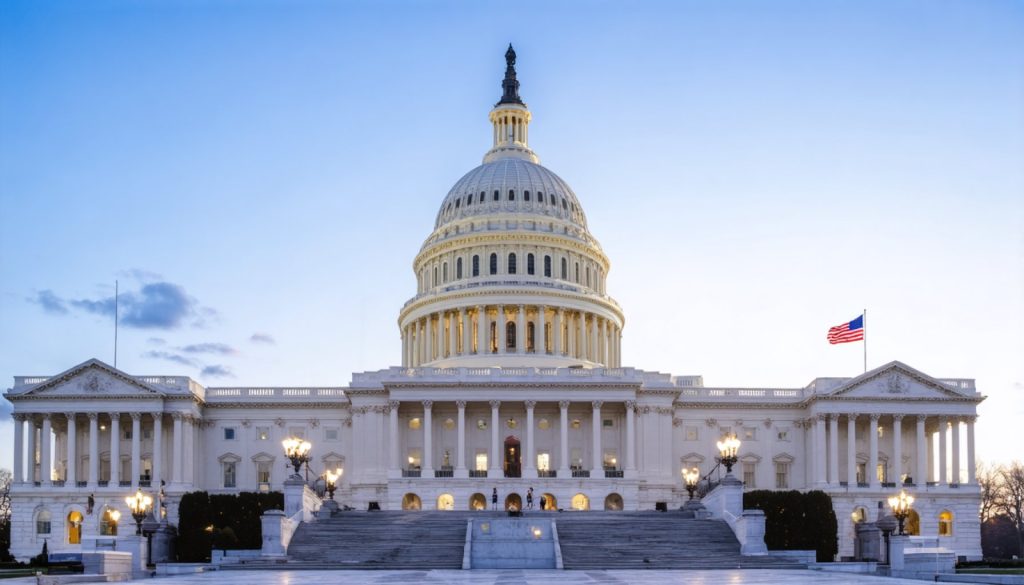
- House Financial Services Committee Chair French Hill leads efforts to regulate stablecoins, emphasizing their role as payment tools rather than investment vehicles.
- The STABLE Act seeks to establish guidelines for stablecoins focusing on reservation, trust, transparency, and financial crime compliance.
- The crypto industry grapples with the decision to limit interest-bearing stablecoins, which many view as stifling innovation in favor of traditional norms.
- Voices from industry leaders like Brian Armstrong and Matt Hougan argue for interest-bearing options to bridge technology with financial growth.
- The core issue remains finding a balance between regulatory oversight and the innovative potential of cryptocurrencies.
- The discussion signals a broader need to integrate new technologies within current financial systems without diminishing their potential.
- A swift, bipartisan approach to stablecoin regulation is urged to maintain the US’s competitive edge in the crypto market.
Witness the unfolding drama on Capitol Hill as lawmakers, led by House Financial Services Committee Chair French Hill, chart a cautious course through the volatile seas of cryptocurrency regulation. Hill’s declaration that stablecoins should solely enhance payments, not offer enticing returns, resounds across the tech-savvy corridors of the crypto industry, leaving enthusiasts and innovators on edge.
Amidst a tapestry of virtual assets evolving at breakneck speed, Hill’s vision is a clarion call for clarity and stability. The crypto community, in its relentless pursuit of innovation, had hoped for more — a regulatory landscape welcoming interest-bearing stablecoins. Yet, Hill emphasizes that consensus is elusive within the House, shaping stablecoins purely as a payment utility rather than an investment tool.
The STABLE Act, poised for markup and fiery debate among committee members, encapsulates this vision. The bill promises rigorous guidelines on reservation, trust, transparency, and financial crime compliance. For Dante Disparte of Circle, this piece of legislation is a beacon, offering a distinct pathway for the incorporation of dollar-referencing stablecoins into the US regulatory framework. The plea? Swift and bipartisan passage, ensuring the United States maintains its competitive edge in this burgeoning market.
But for staunch advocates of financial innovation, the legislative stance spells missed opportunity. Eschewing yield-bearing proposals feels to them like tethering the unbridled potential of crypto to traditional financial norms, merely swapping a digital façade for familiar principles.
Voices of dissent echo from industry stalwarts like Coinbase CEO Brian Armstrong and Bitwise executive Matt Hougan, who had lobbied for the consumer-friendly inclinations of interest-bearing options. Their sentiment suggests a vital intersection of technology and finance remains unexplored, potentially stalling revolutionary developments.
As lawmakers deliberate over the delicate interplay of guidance and innovation, the dialogue highlights a central tension: how to balance robust regulations with the creative dynamism that defines the crypto industry. It’s a tightrope walk between safeguarding markets and nurturing technological advancement.
The key insight? Deliberation on stablecoins invites broader consideration of how best to integrate emerging technologies within existing structures without stifling their inherent potential. As the legislative narrative unfolds, stakeholders are urged to reflect on how the synthesis of stability and innovation might redefine the future financial landscape.
The Future of Crypto: Will Stablecoins Only Serve as Payment Utilities?
Understanding the Current Regulatory Landscape
As the rapid evolution of virtual assets reshapes financial paradigms, the cryptocurrency community finds itself at a crossroads. The discussion led by House Financial Services Committee Chair French Hill centers on the pivotal role stablecoins might play in the future—a tool for enhancing payments but not a vehicle for investment returns. Yet, this perspective has sparked a debate, highlighting the need for stablecoins to balance between stability and financial innovation.
Key Aspects of the STABLE Act
1. Guidelines on Reservation: The STABLE Act aims to establish clear standards for reserve management, ensuring that stablecoins are backed by safe and liquid reserves.
2. Trust and Transparency: Transparency is at the core of the legislation, mandating issuers provide full disclosure regarding the assets backing their stablecoins.
3. Financial Crime Compliance: The bill underscores the necessity for compliance with anti-money laundering and counter-terrorist financing laws.
For Circle’s Dante Disparte, these guidelines offer a roadmap for integrating dollar-referencing stablecoins into the regulatory framework, urging swift bipartisan support to retain U.S. competitiveness in the crypto market.
Exploring the Broader Implications
How-to: Enhance Your Knowledge of Stablecoins
– Understand Their Use: Stablecoins like Tether and USD Coin offer price stability relative to fiat currencies like the U.S. dollar.
– Examine Use Cases: Beyond payments, explore how stablecoins facilitate remittances with lower transaction costs compared to traditional methods.
– Study Regulatory Developments: Keep abreast of legislative changes that can impact stablecoin issuance and use.
Real-World Use Cases and Industry Trends
– Cross-Border Transactions: Stablecoins can revolutionize cross-border payments by reducing transaction times and costs.
– Decentralized Finance (DeFi): These digital currencies are pivotal in DeFi platforms, providing the stability necessary for borrowing and lending services.
Pros and Cons Overview
Pros:
– Facilitates faster, cost-effective transactions.
– Ensures greater financial inclusion.
– Acts as a hedge against fiat currency volatility in unstable economies.
Cons:
– Lack of consumer protections in unregulated environments.
– Potential for misuse in illicit activities without proper oversight.
Controversies and Limitations
Brian Armstrong of Coinbase and Bitwise executive Matt Hougan argue against the limitations imposed by the STABLE Act, suggesting that eschewing yield-bearing opportunities could impede technological and financial innovation.
Insights and Predictions
– Market Growth: As regulatory frameworks stabilize, expect the stablecoin market to grow with potential new applications in both retail and institutional settings.
– Emerging Technology Integration: Integration with blockchain technology could result in innovative financial products that bridge current traditional and digital finance systems.
Actionable Recommendations
1. Stay Informed: Regularly review reliable sources for updates on regulatory changes affecting cryptocurrencies.
2. Diversify Knowledge: Understand both the technical and financial implications of using and investing in stablecoins.
3. Evaluate Platforms: When engaging with stablecoins, ensure that the platforms adhere to regulatory standards and provide transparent operations.
For more insights on financial services and innovation, visit House.gov.
As the dialogue surrounding stablecoins continues to evolve, the key will be crafting frameworks that support innovation while ensuring stability and security within the financial ecosystem.



